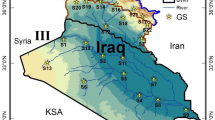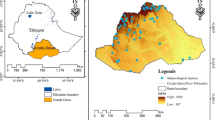Abstract
The precipitation-based indices such as the standardized precipitation index (SPI), the standardized anomaly index (SAI), the rainfall anomaly index (RAI), the percent of normal precipitation (PNP), the China Z index (CZI), and the modified China Z index (MCZI) were compared using monthly precipitation data from 28 synoptic stations in Serbia for the period 1946–2019. The MCZI and CZI showed the lowest similarity to the SPI index that was selected as a reference drought index. According to the findings of the present study, the RAI index was proposed as an index that has the most similar performance to the SPI index. Based on the spatial distribution of the RAI values for the year 2000, the whole region except the western part of Serbia can be classified as extremely dry.





Similar content being viewed by others
Data availability
The data are available from the corresponding author upon request.
References
Anđelković G, Jovanović S, Manojlović S, Samardžić I, Živković L, Šabić D, Gatarić D, Džinović M (2018) Extreme precipitation events in Serbia: defining the threshold criteria for emergency preparedness. Atmosphere 9(5):188. https://doi.org/10.3390/atmos9050188
Blain GC (2011) Standardized precipitation index based on Pearson type III distribution. Revista Brasileira de Meteorologia 26(2):167–180. https://doi.org/10.1590/S0102-77862011000200001
Edwards DC, McKee TB (1997) Characteristics of 20th century drought in the United States at multiple time scales. Atmos Sci 634:1–30
European Commission (2007) Drought management plan report, including agricultural, drought indicators and climate change aspects, water scarcity and droughts expert network. Technical report 2008-023, DG Environment: Luxembourg
Frank A, Armenski T, Gocic M, Popov S, Popovic L, Trajkovic S (2017) Influence of mathematical and physical background of drought indices on their complementarity and drought recognition ability. Atmos Res 194:268–280. https://doi.org/10.1016/j.atmosres.2017.05.006
Gocic M, Trajkovic S (2013) Analysis of precipitation and drought data in Serbia over the period 1980–2010. J Hydrol 494:32–42
Gocic M, Trajkovic S (2014a) Spatiotemporal characteristics of drought in Serbia. J Hydrol 510:110–123
Gocic M, Trajkovic S (2014b) Spatio-temporal patterns of precipitation in Serbia. Theor Appl Climatol 117(3-4):419–431
Gocic M, Trajkovic S, Milanovic M (2020) Precipitation and drought analysis in Serbia for the period 1946–2017. In: Negm A, Romanescu G, Zelenakova M (eds) Water Resources Management in Balkan Countries. Springer Water. Springer, Cham. https://doi.org/10.1007/978-3-030-22468-4_11
Guttman NB (1998) Comparing the palmer drought index and the standardized precipitation index. J Am Water Resour As 34:113–121
Hänsel S, Schucknecht A, Matschullat J (2016) The modified rainfall anomaly index (mRAI)—is this an alternative to the standardised precipitation index (SPI) in evaluating future extreme precipitation characteristics? Theor Appl Climatol 123:827–844
Hrnjak I, Lukić T, Gavrilov MB et al (2014) Aridity in Vojvodina, Serbia. Theor Appl Climatol 115:323–332. https://doi.org/10.1007/s00704-013-0893-1
Kalisa W, Zhang J, Igbawua T, Ujoh F, Ebohon OJ, Namugize JN, Yao F (2020) Spatio-temporal analysis of drought and return periods over the East African region using standardized precipitation index from 1920 to 2016. Agric Water Manag 237:106195
Kendall MG (1975) Rank correlation methods. Griffin, London, UK
Kendall MG, Stuart A (1977) The advanced theory of statistics. Company, London, High Wycombe, Charles Griffin, pp 400–401
Khan MI, Liu D, Fu Q, Faiz MA (2018) Detecting the persistence of drying trends under changing climate conditions using four meteorological drought indices. Meteorol Appl 25(2):184–194
Kraus E (1977) Subtropical droughts and cross-equatorial energy transports. Mon Weather Rev 105(8):1009–1018
Liu Y, Zhu Y, Ren L, Singh VP, Yong B, Jiang S, Yuan F, Yang X (2019) Understanding the spatiotemporal links between meteorological and hydrological droughts from a three-dimensional perspective. J Geophys Res-Atmos 124(6):3090–3109
Mahmoudi P, Rigi A, Miri Kamak M (2019) A comparative study of precipitation-based drought indices with the aim of selecting the best index for drought monitoring in Iran. Theor Appl Climatol 137:3123–3138. https://doi.org/10.1007/s00704-019-02778-z
Mann HB (1945) Nonparametric tests against trend. Econometrica 13:245–259
McKee TB, Doesken NJ, Kleist J (1993) The relationship of drought frequency and duration to time scales. In: 8th Conference on Applied Climatology, Anaheim, USA
Milovanović B, Schuster P, Radovanović M et al (2017) Spatial and temporal variability of precipitation in Serbia for the period 1961–2010. Theor Appl Climatol 130:687–700. https://doi.org/10.1007/s00704-017-2118-5
Milovanović B, Schubert S, Radovanović M, Vakanjac VR, Schneider C (2021) Projected changes in air temperature, precipitation and aridity in Serbia in the 21st century. Int J Climatol 42(3):1985–2003. https://doi.org/10.1002/joc.7348
Mirabbasi R, Anagnostou EN, Fakheri-Fard A, Dinpashoh Y, Eslamian S (2013) Analysis of meteorological drought in Northwest Iran using the joint deficit index. J Hydrol 497:35–48. https://doi.org/10.1016/j.jhydrol.2013.04.019
Mishra AK, Singh VP (2010) A review of drought concepts. J Hydrol 354(1–2):202–216
Morid S, Smakhtin V, Moghaddasi M (2006) Comparison of seven meteorological indices for drought monitoring in Iran. Int J Climatol 27(15):971–985
O'Gorman PA, Schneider T (2009) The physical basis for increases in precipitation extremes in simulations of 21st-century climate change. Proc Natl Acad Sci U S A 106(35):14773–14777
Oikonomou PD, Karavitis CA, Tsesmelis DE, Kolokytha E, Maia R (2020) Drought characteristics assessment in Europe over the past 50 years. Water Resour Manage 34:4757–4772. https://doi.org/10.1007/s11269-020-02688-0
Peña-Gallardo M, Vicente-Serrano SM, Domínguez-Castro F, Beguería S (2019) The impact of drought on the productivity of two rainfed crops in Spain. Nat Hazards Earth Syst Sci 19:1215–1234
Radaković MG, Tošić I, Bačević N et al (2018) The analysis of aridity in Central Serbia from 1949 to 2015. Theor Appl Climatol 133:887–898
Stricevic R, Djurovic N, Djurovic Z (2011) Drought classification in Northern Serbia based on SPI and statistical pattern recognition. Meteorol Appl 18(1):60–69
Sun P, Zhang Q, Wen Q, Singh VP, Shi P (2017) Multisource data based integrated agricultural drought monitoring in the Huai River basin, China. J Geophys Res 122:10751–10772
Tošić I, Unkašević M (2013a) Analysis of wet and dry periods in Serbia. Int J Climatol 34:1357–1368
Tošić I, Unkašević M (2013b) Extreme daily precipitation in Belgrade and their links with the prevailing directions of the air trajectories. Theor Appl Climatol 111:97–107. https://doi.org/10.1007/s00704-012-0647-5
Trajković S, Gocić M, Misic D, Milanovic M (2020) Spatio-temporal distribution of hydrological and meteorological droughts in the South Morava Basin. In: Gocić M, Aronica G, Stavroulakis G, Trajković S (eds) Natural Risk Management and Engineering. Springer Tracts Civ. Eng.. Springer, Cham. https://doi.org/10.1007/978-3-030-39391-5_11
Um MJ, Kim Y, Park D (2018) Evaluation and modification of the drought severity index (DSI) in East Asia. Remote Sens Environ 209:66–76
Unkašević M, Tošić I, Vujović D (2004) Variability and probability of annual and extreme precipitation over Serbia and Montenegro. Theor Appl Climatol 79:103–109. https://doi.org/10.1007/s00704-004-0060-9
Van Rooy MP (1965) A Rainfall anomaly index independent of time and space. Notos 14:43–48
Vicente-Serrano SM, Beguería S, Lorenzo-Lacruz J, Camarero JJ, López-Moreno JI, Azorin-Molina C, Revuelto J, Morán-Tejeda E, Sanchez-Lorenzo A (2012) Performance of drought indices for ecological, agricultural, and hydrological applications. Earth Interact 16(10):1–27
Willeke G, Hosking JRM, Wallis JR, Guttmann NB (1994) The national drought atlas. In: Institute for Water Resources Rep. 94- NDS-4. Army Corps of Engineers, U.S
World Meteorological Organization (2012) Standardized precipitation index used guide. WMO-No 1090, Switzerland
Wu H, Hayes MJ, Weiss A, Hu QI (2001) An evaluation of the standardized precipitation index, the China-Z index and the statistical Z-score. Int J Climatol 21(6):745–758
Zargar A, Sadiq R, Naser B, Khan FI (2011) A review of drought indices. Environ Rev 19:333–349
Zhang M, Yuan X (2020) Rapid reduction in ecosystem productivity caused by flash drought based on decade-long FLUXNET observations. Hydrol Earth Syst Sci 24:5579–5593
Author information
Authors and Affiliations
Contributions
Mohammad Arab Amiri prepared a methodology part, applied necessary methods using different software, and wrote the draft version of the manuscript. Milan Gocic conceptualized the manuscript and did the supervision and validation.
Corresponding author
Ethics declarations
Consent to participate
In our research, we have not involved human subjects. Also, this study is not related to the human transplantation studies. This manuscript does not report studies involving vulnerable groups.
Conflict of interest
The authors declare no competing interests.
Additional information
Publisher’s note
Springer Nature remains neutral with regard to jurisdictional claims in published maps and institutional affiliations.
Rights and permissions
Springer Nature or its licensor (e.g. a society or other partner) holds exclusive rights to this article under a publishing agreement with the author(s) or other rightsholder(s); author self-archiving of the accepted manuscript version of this article is solely governed by the terms of such publishing agreement and applicable law.
About this article
Cite this article
Amiri, M.A., Gocic, M. Analysis of temporal and spatial variations of drought over Serbia by investigating the applicability of precipitation-based drought indices. Theor Appl Climatol 154, 261–274 (2023). https://doi.org/10.1007/s00704-023-04554-6
Received:
Accepted:
Published:
Issue Date:
DOI: https://doi.org/10.1007/s00704-023-04554-6




